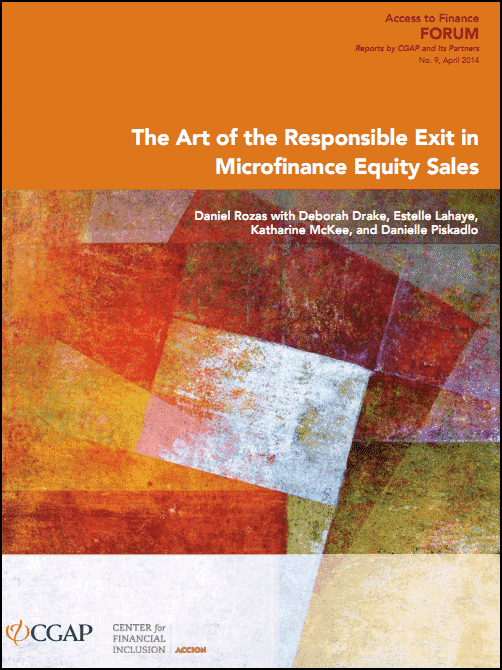In this paper the Center for Financial Inclusion at Accion (CFI) and the Consultative Group to Assist the Poor (CGAP) seek to spark discussion among the stakeholders working to advance financial inclusion and in particular the investor community that will result in greater clarity around the goal of responsible exits and the policies and practices that would support it.
THE ART OF THE RESPONSIBLE EXIT IN MICROFINANCE EQUITY SALES
Download at the link below: Art-of-the-Responsible-Exit-Microfinance-2014.pdf
KEY FINDINGS OF REPORT
Exits of equity investments are still relatively recent but lessons on how to ensure ongoing responsible behavior by partners and the broader market are emerging. There are several overarching themes that affect the options that investors are likely to face: market context and stage of development; share of ownership being sold; and the MFI’s ownership structure, governance arrangements, and place in its life cycle. As a result, there is no single approach to ensure a responsible exit.
However, investors need to carefully think about four main strategic decisions:
1. When? The desired timing and avenue of exit should form a key part of an investor’s decision to invest. These plans and preferences should be discussed with the other equity investors and the MFI’s management. That said, rarely did the exit opportunity materialize exactly as planned, and the ability to adapt and respond flexibly was a feature in many exits. For fixed-term funds, exit timing is built into the prospectus, but at least one case study suggests that this structure may not be optimal for the specific role of anchor investors. 2. To Whom? There are advantages and disadvantages of selling to a microfinance investor versus an investor outside of the microfinance ecosystem. On the one hand, it is easier to find a like-minded buyer within the ecosystem, which can mitigate concerns about mission drift or reputation risk. On the other hand, for more mature MFIs, investors such as local or regional banks might be better placed to play a strategic role by bringing strong balance sheets, operational expertise, and local market linkages that the MFIs need to develop further. Exiting DFIs and MIIs can be guided by careful and deliberate due diligence to ascertain the buyer’s intentions and commitment to the MFI’s mission, combined with judgment about the kind of capital and expertise the MFI most needs in its next chapter. 3. How? In principle, putting provisions in shareholder agreements and setting up alternative mission-oriented governance structures could help enshrine the MFI’s mission and social commitments to send an important signal to potential investors when current owners seek a buyer for their shares. We analyze several examples of this approach. It should be noted, however, that the legal enforceability of such provisions varies widely and their relevance may be limited when a controlling stake is being sold. The risk also exists that overly restrictive and complex legal provisions could pose unreasonable barriers to exit. 4. How Much? The selling party may have multiple offers to choose from, with each bidder offering a different mix of price and nonprice characteristics. Since cashing out nearly always entails giving up say over the investee’s future social or developmental mission, we examined more specifically how investors described weighing price- versus mission-related features of the potential new owner. The findings suggest that many investors currently may be using a two-step process in which they first screen buyers for suitability (including mission fit) and then make their final selection based on the most attractive price. We also note that high-priced sales to new buyers in the microfinance sector may risk locking an MFI into a strategy that may harm both its clients and the broader market. Finally, because of their specific mandate, DFIs have a special role to play in private-sector development. The way they exit—when, how, to whom, and for how much—can send important signals to other market players. By integrating a market development dimension into these four key decisions, DFIs have an opportunity to fulfill their mandate to play a broader catalytic role.
